 As far as the Claus Count Schenk von Stauffenberg bomb situation is concerned, the cooperation on the part of the British Services was entirely unknown to them and not solicited in any way. The plastic (explosive) was obtained from (parachute) drops to the resistance movements in Holland, France and Denmark where in some cases, Funkspiele (radio games) from captured transmitters were employed, particularly in Holland as Germany did not have any product even similar to plastic, which was dropped for saboteurs mainly to blow up rail connections, factories, ships and the like. Such captured supplies were furnished by the Abwehr on at least four different occasions.
As far as the Claus Count Schenk von Stauffenberg bomb situation is concerned, the cooperation on the part of the British Services was entirely unknown to them and not solicited in any way. The plastic (explosive) was obtained from (parachute) drops to the resistance movements in Holland, France and Denmark where in some cases, Funkspiele (radio games) from captured transmitters were employed, particularly in Holland as Germany did not have any product even similar to plastic, which was dropped for saboteurs mainly to blow up rail connections, factories, ships and the like. Such captured supplies were furnished by the Abwehr on at least four different occasions.
Thanks to plastic explosives dropped by the British, there was enough of this sophisticated explosive for not one, but four attempts on Hitler’s life.
First, the contemplated attempt by Army Captain Axel von dem Busche to literally jump Adolf Hitler during a demonstration of new winter uniforms and new equipment, with the intent to clutch him and blow himself up at the same time with the plastic that had been incorporated into his uniform and personal equipment. But Hitler changed his mind and declined to attend the demonstration at the Russian Front and thus the deal did not materialize.
Second, a package with two bottles, one containing Cognac and the second bottle containing plastic with a detonator were handed to the unsuspecting Colonel Brand, just prior to his return with Hitler’s aircraft to East Prussia (Rastenburg) from Vinitza Airport in Russia. However, the prevalent cold of the higher than anticipated altitude of the aircraft froze the detonators liquid and thus this attempt misfired as well. After it was realized, the package of ‘Cognac’ bottles was retrieved with considerable difficulty but still unopened, and picked up by a confidant of the originators at Army Group Middle under the direction of Henning von Treskow, who killed himself after the 20th of July attempt did not work out as planned.
The 3rd attempt was also by Claus Count Schenk von Stauffenberg, several days prior to the 20th of July 1944. It was handled exactly the same way, but he did not activate the delayed detonator because only Adolf Hitler was present at the meeting and he also wanted to blow up Heinrich Himmler as well as Hermann Göring in addition at the same time. Consequently he decided not to go ahead the first time as they were not present.
But the British did not know of their involuntary cooperation until after the war actually. Few people realize this past history and even too few really did know what did transpire on July 20th in 1944. I would say that 99½% of the Kriegsmarine officers were just as surprised as the average man in the street, so to speak, as they were neither involved in these different developments and too far removed from what happened on the Eastern Front and even within Germany generally. The Kriegsmarine was a separate and rather closely knit ‘club’ that, by and large, had little daily contact with either the Army or any other part of the establishment in power and basically everybody was only concerned with the war at sea, the elements and the oceans being ‘Enemy No. ONE’ mostly.
In KTB #159 next month, we will read an analysis of the two agents dropped ashore from U-1230 in Maine - they are the subjects of our ongoing story ‘Spy for Germany’. It is interesting.
Back to KTB # 158 Table of Contents
Back to KTB List of Issues
Back to MagWeb Master Magazine List
© Copyright 2001 by Harry Cooper, Sharkhunters International, Inc.
This article appears in MagWeb (Magazine Web) on the Internet World Wide Web. Other military history articles articles are available at http://www.magweb.com
Join Sharkhunters International, Inc.: PO Box 1539, Hernando, FL 34442, ph: 352-637-2917, fax: 352-637-6289, www.sharkhunters.com
